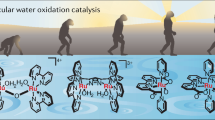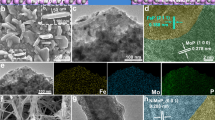Abstract
The success of solar fuel technology relies on the development of efficient catalysts that can oxidize or reduce water. All molecular water-oxidation catalysts reported thus far are transition-metal complexes, however, here we report catalytic water oxidation to give oxygen by a fully organic compound, the N(5)-ethylflavinium ion, Et-Fl+. Evolution of oxygen was detected during bulk electrolysis of aqueous Et-Fl+ solutions at several potentials above +1.9 V versus normal hydrogen electrode. The catalysis was found to occur on glassy carbon and platinum working electrodes, but no catalysis was observed on fluoride-doped tin-oxide electrodes. Based on spectroelectrochemical results and preliminary calculations with density functional theory, one possible mechanistic route is proposed in which the oxygen evolution occurs from a peroxide intermediate formed between the oxidized flavin pseudobase and the oxidized carbon electrode. These findings offer an organic alternative to the traditional water-oxidation catalysts based on transition metals.
This is a preview of subscription content, access via your institution
Access options
Subscribe to this journal
Receive 12 print issues and online access
$259.00 per year
only $21.58 per issue
Buy this article
- Purchase on Springer Link
- Instant access to full article PDF
Prices may be subject to local taxes which are calculated during checkout






Similar content being viewed by others
References
Lewis, N. S. & Nocera, D. G. Powering the planet: chemical challenges in solar energy utilization. Proc. Natl Acad. Sci. USA 103, 15729–15735 (2006).
Gust, D., Moore, T. A. & Moore, A. L. Solar fuels via artificial photosynthesis. Acc. Chem. Res. 42, 1890–1898 (2009).
Gray, H. B. Powering the planet with solar fuel. Nature Chem. 1, 7 (2009).
Hernandez-Pagan, E. A., Wang, W. & Mallouk, T. E. Template electrodeposition of single-phase p- and n-type copper indium diselenide (CuInSe2) nanowire arrays. ACS Nano 5, 3237–3241 (2011).
McFarlane, S. L. et al. Designing electronic/ionic conducting membranes for artificial photosynthesis. Energy Environ. Sci. 4, 1700–1703 (2011).
Kanan, M. W. & Nocera, D. G. In situ formation of an oxygen-evolving catalyst in neutral water containing phosphate and Co2+. Science 321, 1072–1075 (2008).
Jaramillo, T. F. et al. Identification of active edge sites for electrochemical H2 evolution from MoS2 nanocatalysts. Science 317, 100–102 (2007).
Betley, T. A., Wu, Q., Van Voorhis, T. & Nocera, D. G. Electronic design criteria for O–O bond formation via metal–oxo complexes. Inorg. Chem. 47, 1849–1861 (2008).
Liu, F. et al. Mechanisms of water oxidation from the blue dimer to photosystem II. Inorg. Chem. 47, 1727–1752 (2008).
Brimblecombe, R., Dismukes, G. C., Swiegers, G. F. & Spiccia, L. Molecular water-oxidation catalysts for photoelectrochemical cells. Dalton Trans. 9374–9384 (2009).
Concepcion, J. J., Tsai, M. K., Muckerman, J. T. & Meyer, T. J. Mechanism of water oxidation by single-site ruthenium complex catalysts. J. Am. Chem. Soc. 132, 1545–1557 (2010).
Nyhlen, J. et al. Evolution of O2 in a seven-coordinate RuIV dimer complex with a [HOHOH]− bridge: a computational study. Angew. Chem. Int. Ed. 49, 1773–1777 (2010).
Sala, X. et al. Molecular catalysts that oxidize water to dioxygen. Angew. Chem. Int. Ed. 48, 2842–2852 (2009).
Zong, R. & Thummel, R. P. A new family of Ru complexes for water oxidation. J. Am. Chem. Soc. 127, 12802–12803 (2005).
Kohl, S. W. et al. Consecutive thermal H2 and light-induced O2 evolution from water promoted by a metal complex. Science 324, 74–77 (2009).
McDaniel, N. D., Coughlin, F. J., Tinker, L. L. & Bernhard, S. Cyclometalated iridium(III) aquo complexes: efficient and tunable catalysts for the homogeneous oxidation of water. J. Am. Chem. Soc. 130, 210–217 (2008).
Kunkely, H. & Vogler, A. Water splitting by light with osmocene as photocatalyst. Angew. Chem. Int. Ed. 48, 1685–1687 (2009).
Limburg, J. et al. A functional model for O–O bond formation by the O2-evolving complex in photosystem II. Science 283, 1524–1527 (1999).
Ellis, W. C., McDaniel, N. D., Bernhard, S. & Collins, T. J. Fast water oxidation using iron. J. Am. Chem. Soc. 132, 10990–10991 (2010).
Yin, Q. et al. A fast soluble carbon-free molecular water oxidation catalyst based on abundant metals. Science 328, 342–345 (2010).
Friend, R. H. et al. Electroluminescence in conjugated polymers. Nature 397, 121–128 (1999).
Guenes, S., Neugebauer, H. & Sariciftci, N. S. Conjugated polymer-based organic solar cells. Chem. Rev. 107, 1324–1338 (2007).
Lutterman, D. A., Surendranath, Y. & Nocera, D. G. A self-healing oxygen-evolving catalyst. J. Am. Chem. Soc. 131, 3838–3839 (2009).
Ham, M-H. et al. Photoelectrochemical complexes for solar energy conversion that chemically and autonomously regenerate. Nature Chem. 2, 929–936 (2010).
Sichula, V. et al. Mechanism of N(5)-ethyl-flavinium cation formation upon electrochemical oxidation of N(5)-ethyl-4a-hydroxyflavin pseudobase. J. Phys. Chem. B 114, 9452–9461 (2010).
Sichula, V. et al. Electronic properties of N(5)-ethyl flavinium ion. J. Phys. Chem. A 46, 12138–12147 (2010).
Gallagher, K. G. & Fuller, T. F. Kinetic model of the electrochemical oxidation of graphitic carbon in acidic environments. Phys. Chem. Chem. Phys. 11, 11557–11567 (2009).
Ruttinger, W. & Dismukes, G. C. Synthetic water-oxidation catalysts for artificial photosynthetic water oxidation. Chem. Rev. 97, 1–24 (1997).
Sawyer, D. T. et al. Effects of media and electrode materials on the electrochemical reduction of dioxygen. Anal. Chem. 54, 1720–1724 (1982).
Cady, C. W., Crabtree, R. H. & Brudvig, G. W. Functional models for the oxygen-evolving complex of photosystem II. Coord. Chem. Rev. 252, 444–455 (2008).
Gersten, S. W., Samuels, G. J. & Meyer, T. J. Catalytic oxidation of water by an oxo-bridged ruthenium dimer. J. Am. Chem. Soc. 104, 4029–4030 (1982).
Collin, J. P. & Sauvage, J. P. Synthesis and study of mononuclear ruthenium(II) complexes of sterically hindering diimine chelates. Implications for the catalytic oxidation of water to molecular oxygen. Inorg. Chem. 25, 135–141 (1986).
Concepcion, J. J., Jurss, J. W., Hoertz, P. G. & Meyer, T. J. Catalytic and surface-electrocatalytic water oxidation by redox mediator–catalyst assemblies. Angew. Chem. Int. Ed. 48, 9473–9476 (2009).
Kinoshita, K. Carbon: Electrochemical and Physicochemical (Wiley, 1988).
Gong, K. P. et al. Nitrogen-doped carbon nanotube arrays with high electrocatalytic activity for oxygen reduction. Science 323, 760–764 (2009).
Qu, L. Nitrogen-doped graphene as efficient metal-free electrocatalyst for oxygen reduction in fuel cells. ACS Nano 4, 1321–1326 (2010).
Mager, H. I. X. et al. Reversible one-electron generation of 4a,5-substituted flavin radical cations – models for a postulated key intermediate in bacterial bioluminescence. J. Am. Chem. Soc. 110, 3759–3762 (1988).
Zhou, D. et al. Fast excited-state deactivation in N(5)-ethyl-4a-hydroxyflavin pseudobase. J. Phys. Chem. B 115, 7136–7143 (2011).
Harris, P. J. F. Structure of non-graphitising carbons. Int. Mater. Rev. 42, 206–218 (1997).
Lafleur, A. L. et al. Identification of C20H10 dicyclopentapyrenes in flames: correlation with corannulene and fullerene formation. J. Phys. Chem. 100, 17421–17428 (1996).
Creegan, K. M. et al. Synthesis and characterization of C60O, the 1st fullerene epoxide. J. Am. Chem. Soc. 114, 1103–1105 (1992).
He, H., Swami, N. & Koel, B. E. Reaction of C60 with oxygen adatoms on Pt(111). J. Chem. Phys. 110, 1173–1179 (1999).
Steckel, J. A., Jordan, K. D. & Avouris, P. Oxygen atom reactions with circumtrindene and related molecules: analogues for the oxidation of nanotube caps. J. Phys. Chem. A 106, 2572–2579 (2002).
Rudolph, M., Reddy, D. P. & Feldberg, S. W. A simulator for cyclic voltammetric responses. Anal. Chem. 66, 589A–600A (1994).
Hua, F. et al. Luminescent charge-transfer platinum(II) metallacycle. Inorg. Chem. 46, 8771–8783 (2007).
Frisch, M. J. et al. Gaussian 09, Revision A.1. (Gaussian, 2009).
Lee, C. T., Yang, W. T. & Parr, R. G. Development of the Colle–Salvetti correlation-energy formula into a functional of the electron density. Phys. Rev. B 37, 785–789 (1988).
Becke, A. D. Density-functional exchange-energy approximation with correct asymptotic-behavior. Phys. Rev. A 38, 3098–3100 (1988).
Tomasi, J. & Persico, M. Molecular interactions in solution: an overview of methods based on continuous distributions of the solvent. Chem. Rev. 94, 2027–2094 (1994).
Acknowledgements
We thank T. J. Meyer and C. L. Hill for their useful insights, and F. N. Castellano and T. E. Mallouk for their help with spectroelectrochemical and RRDE experiments. This work was supported by Bowling Green State University, National Science Foundation (CHE-1055397 CAREER award to K.D.G. and CHE-0743258 for C.M.H.) and the Ohio Supercomputer Center. S.V. acknowledges an Ohio State University Presidential Fellowship.
Author information
Authors and Affiliations
Contributions
R.K. and T.C. synthesized Et-Fl+ and Et-FlOH. E.M. performed cyclic voltammetry, bulk electrolysis and spectroelectrochemistry and co-wrote the paper. J.W. and N.M.V-B. performed the RRDE experiments. J.W. performed the mass spectrometry experiments. S.V., S.O., S.F.M. and C.M.H. performed theoretical calculations. K.D.G. designed the research, analysed the data and co-wrote the paper.
Corresponding author
Ethics declarations
Competing interests
The authors declare no competing financial interests.
Supplementary information
Supplementary information
Supplementary information (PDF 1463 kb)
Rights and permissions
About this article
Cite this article
Mirzakulova, E., Khatmullin, R., Walpita, J. et al. Electrode-assisted catalytic water oxidation by a flavin derivative. Nature Chem 4, 794–801 (2012). https://doi.org/10.1038/nchem.1439
Received:
Accepted:
Published:
Issue Date:
DOI: https://doi.org/10.1038/nchem.1439
This article is cited by
-
Triarylmethyl cation redox mediators enhance Li–O2 battery discharge capacities
Nature Chemistry (2023)
-
3D Nanostructured Nickel Hydroxide as an Efficient Electrocatalyst for Oxygen Evolution Reaction
Electrocatalysis (2022)
-
Toward a mechanistic understanding of electrocatalytic nanocarbon
Nature Communications (2021)
-
Single atom tungsten doped ultrathin α-Ni(OH)2 for enhanced electrocatalytic water oxidation
Nature Communications (2019)
-
High OER performance Ni(OH)2 with hierarchical structure
Journal of Solid State Electrochemistry (2019)



